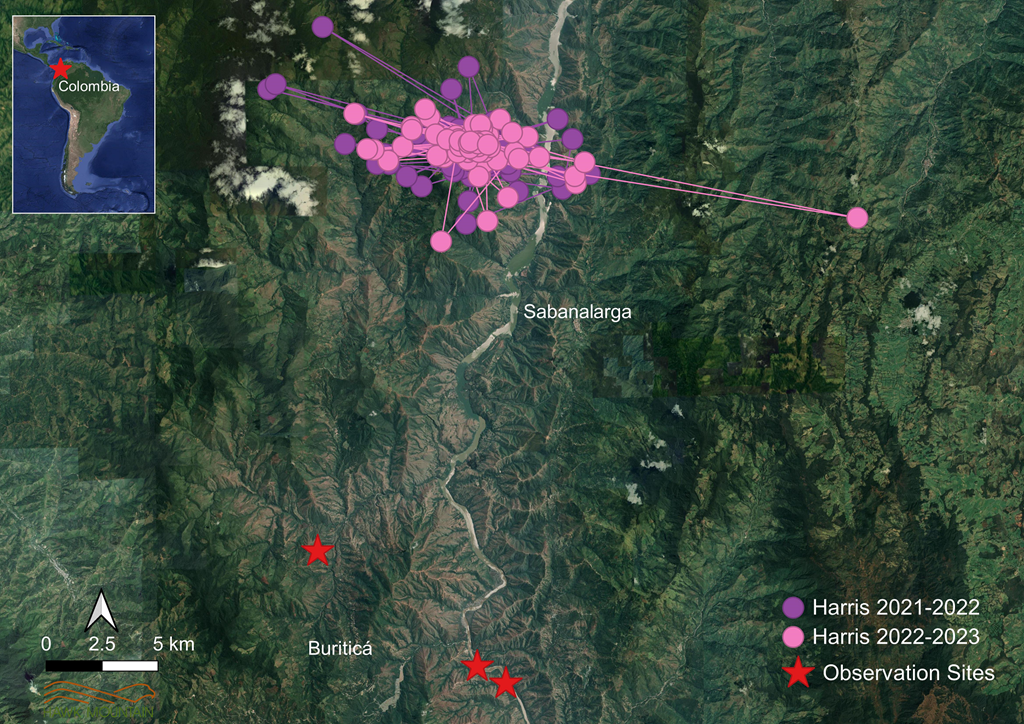Visiting Harris the Broadwing at His Winter Home in Colombia
Posted on in In the Field by Ana Maria Castaño Rivas, Hawk Mountain Board Member
Read the Spanish translation of this blog here.

The Broad-winged Hawk Project at Hawk Mountain was launched in 2014 with a goal of studying broad-winged hawks (hereafter broadwings) throughout the year to understand conservation threats and priorities for the species. Broadwings have been declining in some regions of their range, and because little was known about migration and wintering ecology, Hawk Mountain has tracked a small sample of birds from Pennsylvania, Connecticut, Ontario, and New Hampshire to understand where different populations winter and what threats they face.
In 2021 and 2022, the research team, led by Hawk Mountain staff Rebecca McCabe and Laurie Goodrich, trapped and tagged five adult broadwings in New Hampshire to compare to birds tracked from Pennsylvania and other populations. One of the birds tagged was a male named “Harris” in honor of the New Hampshire collaborators on the project, the Harris Center for Conservation Education.
Learning about wintering broadwings in the tropics has always been a challenge. Thanks to satellite tracking technology, it is possible to know the exact places where birds are visiting. In 2021 and 2022, Harris visited the same wintering area in north-central Colombia; his daily movements are tracked on the Hawk Mountain website at hawkmountain.org/birdtracker.
In January, Laurie sent me a map of Harris’s movements in a place close to my hometown, asking if we could get actual photos of the ecosystem in the area. Harris was using the same spots over and over, between the municipalities of Sabanalarga and Buriticá in the northwest of Antioquia, frequently flying over the Cauca River. I scheduled a trip to an area nearby that I thought would give me perspective, but it was so huge that I realized additional help was needed.
We have such a connected network of people interested in birds in Colombia, so I decided to launch a request in our chats. I asked if anyone was near either of the two municipalities and if they were willing to share photos of the ecosystem so we could learn more about where Harris was spending his winter.

The response was quick! Within a couple of days, a group of young conservationists from Cañasgordas, a nearby municipality, were doing surveys in the area, and they shared photos of the terrain (thanks to Juan Diego Quiroz and Mayra Parra who immediately reached out to all their partners from the Techo de Agua NGO). They collected pictures and coordinates as well as habitat descriptions. This group has been working with the black and chestnut eagle and have a special passion for raptors. Not only were they checking for habitat characteristics, but they also sent us blurry pictures of broadwings they reported from the area. They really wanted to see Harris, who can be identified by his blue color bands. Unfortunately, there was no actual sighting of him, but they remain hopeful that they will see him.
Another birdwatcher, Felipe Vargas, was doing an environmental assessment in the area and immediately sent me pictures and coordinates. He was so excited about the opportunity to help learn a bit more about where broadwings spend time in our state.
The second day after launching the request I got a call from the head of an environmental department of a petroleum exploration company asking if I still needed footage from the area. Her boss happened to be an avid birder, and when he heard about our needs, he sent his entire environmental team to the area, and they collected a bunch of different pictures of a variety of ecosystems! Thanks to Mario Rodriguez and Angelica Salas from Petroseismic Services, their entire team are now very curious about migratory raptors.
We managed to receive habitat photos representing Tropical Dry Forest and Lower Montane Humid Forest. The area Harris uses is very steep. Pictures were representing a range of heights between 150 to 6500 feet above sea level. The higher the elevation in the mountains, the higher the humidity, so there is a transition across his winter range from dry to humid forests as you climb up.
The municipality of Sabanalarga is located at the east and Buriticá is found west of Cauca River. This river is one of the most important rivers in the country, and it has a flow estimated around 2,900 cubic meters per second. In general, the area has strong landscape alterations for cattle ranches, and the remaining forested areas are still there mostly because of the steep slopes that make it impossible for agriculture and cattle to be productive. There are big areas with secondary growth of forests, grass, and isolated trees.
During the visit, observers reported seeing several broadwings indicating this region could be an important wintering area for broadwings. In the Hawk Mountain study, one other New Hampshire bird, a female named Monadnock, also wintered in this region of Colombia. It is amazing to learn how different the landscape is for Harris from his southern New Hampshire summer home to his northern Colombia winter home!
For more information on The Broad-winged Hawk Project visit hawkmountain.org/broadwing. Want to support this project? Learn how you can Adopt-a-Broadwing here.
Read the Spanish translation of this blog here.